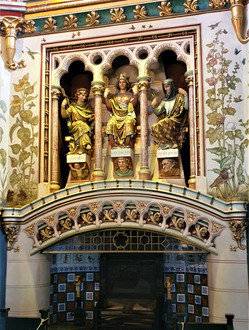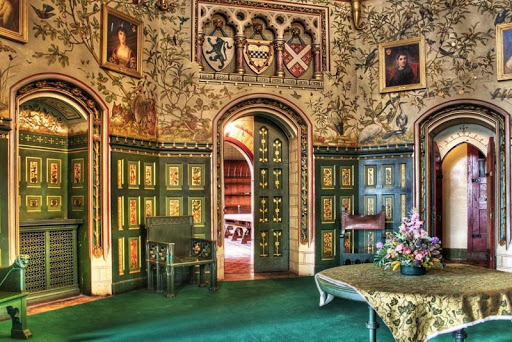Castell Coch - Enchanting Haven's
- Lilium

- Mar 29, 2020
- 5 min read
Updated: Feb 22, 2021
The Three Fates, Aesop's Fables and lascivious animals all combine in an eccentric genius' romantic vision of the Middle Ages.

Castell Coch is a 19th-century Gothic Revival castle built above the village of Tongwynlais in South Wales by the 3rd Marquess of Bute and William Burges. It has one of the most beautiful and ornate interiors in Wales, every panel and door has some hidden meaning in the gilt but first let us introduce the Marquess.
John Patrick Crichton-Stuart, 3rd Marquess of Bute was an aristocrat, industrial magnate, antiquarian, scholar, philanthropist, and architectural patron. He had a vast range of interests which included archaeology, theology, linguistics, religion, medievalism, the occult, philanthropy and history. Succeeding to the marquisate at the age of only six months, his vast inheritance reportedly made him the richest man in the world. He was later educated at Harrow and Christ Church, Oxford but Bute had been attracted to to the Roman Catholic Church since childhood and his conversion to Catholicism at the age of 21 scandalised Victorian society which led Disraeli to use the Marquess as the basis for the eponymous hero of his novel Lothair.
The Marquess was also a prolific writer and he published books on a wide range of topics and was also a somewhat reluctant businessman. Bute's eclectic early education gave him a lifelong interest in architecture, and his father's accumulated wealth gave him the means to indulge this interest on a stupendous scale. But the Marquesses lasting legacy was not for his books on the Celtic or medical period but to be known as "the greatest builder of country houses in nineteenth-century Britain".

In 1865, the Marquess met William Burges and the two embarked on a great architectural partnership. Bute's desires and money allied with Burges' fantastical imagination and skill led to the creation of two of the finest examples of the late Victorian era Gothic Revival, Cardiff Castle and Castell Coch.

The ‘eccentric genius’ William Burges was hired to create a rural retreat to complement the opulence of his main residence, Cardiff Castle. Bute asked Burges to reconstruct the castle ruins he had inherited “as a country residence for occasional occupation in the summer".
Left is William Burges's plans for the reconstruction, showing the surviving medieval features (bottom) and his intentions for the new building (top).
"For sheer powers of intoxication, Burges stands unrivalled."
- Handley-Read on Burges decoration of Cardiff Castle and Castell Coch.

Among the greatest of the Victorian art-architects, he sought in his work to escape from nineteenth-century industrialisation and re-establish the architectural values of a utopian medieval England.
Burges works within the tradition of the Gothic Revival, his creations echoing those of the Pre-Raphaelites. Architecture was not Burges only interest, he designed metalwork, sculpture, jewellery, furniture and stained glass.
In 1864 he gave a series of lectures to the Society of Arts "Art Applied to Industry" showing the breadth of his interests with topics covering glass, metal work, pottery, furniture and external architectural decoration.
Joseph Mordaunt Crook wrote that the castle represented "the learned dream world of a great patron and his favourite architect, recreating from a heap of rubble a fairy-tale castle which seems almost to have materialised from the margins of a medieval manuscript."

My favourite room is The Drawing Room. At the time of it's design Burges noted that he intended to "indulge in a little more ornament" than elsewhere in the castle and indulge he did. Occupying the first and second floor of the Keep, the octagonal Drawing room, topped by minstrel galleries, focuses on what Newman described as "intertwined themes (of) the fecundity of nature and the fragility of life".
"A fireplace by Thomas Nicholls features the Three Fates, the trio of Greek goddesses who are depicted spinning, measuring and cutting the thread of life.The ceiling's vaulting is carved with butterflies, reaching up to a golden sunburst at the apex of the room, while plumed birds fly up into a starry sky in the intervening sections. Around the room, 58 panels, each depicting one or more unique plants, are surmounted by a mural showing animals from twenty-four of Aesop's Fables. The plants are wild flowers from the Mediterranean, where Lord Bute spent his winter months each year. Carved birds, lizards and other wildlife decorate the doorways."

The historian Terry Measham wrote that the Drawing Room and Lady Bute's Bedroom, "so powerful in their effect, are the two most important interiors in the castle." The architectural writer Andrew Lilwall-Smith considered the Drawing Room to be "Burges's pièce de résistance", encapsulating his "romantic vision of the Middle Ages".
This is most likely my favourite room in the world for you could sit in one of it's window seats every day for 10 years and still see something new that you had previously missed, a hare hidden in an alcove or a robin soaring across the ceiling through the stars.
As a child, I saw the turrets of the castle in a sea of trees, that seemed as though it would all topple off the side of the cliff, down to the road below at any moment. I was relieved that it never did. Although watching, year after year, rock climbers climb the rock face to the top did not ease my concern.
Almost every weekend I would cycle from my home, following the river up to the village below the castle, stopping by the pub and then into, in my opinion at least, one of the most beautiful woods in the country.
Fforest Fawr is well loved and looked after with great care and attention. The trees are strong and healthy with paths winding through them and across the many streams that flow down the the hill.

In the spring the ground of the forest is carpeted with native English bluebells, their soft scent in the air and the buds of the trees slowly bring back the long awaited green. The bluebells are then replace by the smell of wild garlic, the glossy leaves and little white flowers covering every floor of the surrounding hills. It is the scent that I most associate with coming home.

In the summer, playing as knights in the mote of the Castell, running through the woods with the dogs as a breeze rustles the leaves of the trees that seem to go on forever. Fforest Fawr is my paradise and no other place will feel as much as home as here.
The Castell all but disappears in autumn in the red and orange. The leaves rain like pure gold, gently falling in the last breath of summer wind and so the forest gains a new carpet that beneath foot makes such pleasant sounds.

In winter the red of the castell is the only colour in the sea of bare bone trees until the most desired weather of the season finally sweeps across the mountains and the red castle becomes the white castle as every turrets is covered in snow.
I don't have many memories from my childhood but I remember Christmas here. The Castell lit up in all its glory, the courtyard filled with stalls where my mother bought luxurious velvet beaded tree ornaments. Traditional Christmas trees were in all the main rooms and the air smelt of Christmas cookies and spiced orange pomanders.













































Comments